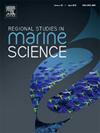Variability of mesoscale eddies and their kinetic energy in the Bay of Bengal using a high-resolution ocean model
IF 2.4
4区 环境科学与生态学
Q3 ECOLOGY
引用次数: 0
Abstract
Oceanic eddies significantly contribute to the mixing of tracers such as temperature, salinity, and nutrients. Eddies are crucial to energy transfer and ocean circulation. The Bay of Bengal (BoB) is a naturally suitable location for intense eddy activity because of its distinct geographical and meteorological characteristics. Using a high-resolution regional ocean model, the mesoscale eddies in the BoB were detected, and their variability was examined in the current study. The model results show good agreement with the available observations. Both geometrical and dynamical approaches are used to identify and track the eddies, which aids in the removal of the frontal jets. The seasonal distribution of eddies, their spatial features, and propagation pathways are investigated. Following the identification and separation of the cyclonic eddy (CE) from the anticyclonic eddy (AE), the kinetic energy of each individual eddy is computed. In the western BoB, the variability of the East India Coastal Current (EICC) dictates eddy generation. The river discharge and bathymetry play a crucial role in determining eddy formation and its features in the northern BoB. Throughout the year, the radius of AEs is greater than that of CEs, reaching its maximum during the pre-monsoon (MAM) season. Compared to CEs, there is a stronger correlation between the size and energy of AEs. Eddie's share of the BoB's overall kinetic energy fluctuates from 7.2 % in March to 19.1 % in November. The seasonal contribution of eddies to the eddy kinetic energy (EKE) of the BoB is discussed, along with the varying strength and direction of winds and surface currents.
利用高分辨率海洋模式分析孟加拉湾中尺度涡旋及其动能的变率
海洋涡旋对温度、盐度和营养物质等示踪剂的混合起着重要作用。涡流对能量传递和海洋环流至关重要。孟加拉湾由于其独特的地理和气象特征,是强涡旋活动的天然适宜地点。利用一个高分辨率的区域海洋模式,检测了BoB的中尺度涡旋,并对其变异性进行了研究。模型结果与现有观测值吻合较好。几何和动力学方法都被用来识别和跟踪涡流,这有助于去除正面射流。研究了涡旋的季节分布、空间特征和传播途径。在对气旋涡旋(CE)和反气旋涡旋(AE)进行识别和分离之后,计算了每个单独涡旋的动能。东印度海岸流(EICC)的变率决定了东印度海岸流的涡动产生。河流流量和水深在确定北段涡旋形成及其特征方面起着至关重要的作用。全年,ae的半径大于ce的半径,在季风前(MAM)季节达到最大。与电子能谱相比,电子能谱的大小和能量之间有更强的相关性。Eddie在BoB总动能中的份额从3月份的7. %波动到11月份的19.1% %。讨论了涡旋对涡旋动能(EKE)的季节性贡献,以及风和海流强度和方向的变化。
本文章由计算机程序翻译,如有差异,请以英文原文为准。
求助全文
约1分钟内获得全文
求助全文
来源期刊

Regional Studies in Marine Science
Agricultural and Biological Sciences-Ecology, Evolution, Behavior and Systematics
CiteScore
3.90
自引率
4.80%
发文量
336
审稿时长
69 days
期刊介绍:
REGIONAL STUDIES IN MARINE SCIENCE will publish scientifically sound papers on regional aspects of maritime and marine resources in estuaries, coastal zones, continental shelf, the seas and oceans.
 求助内容:
求助内容: 应助结果提醒方式:
应助结果提醒方式:


